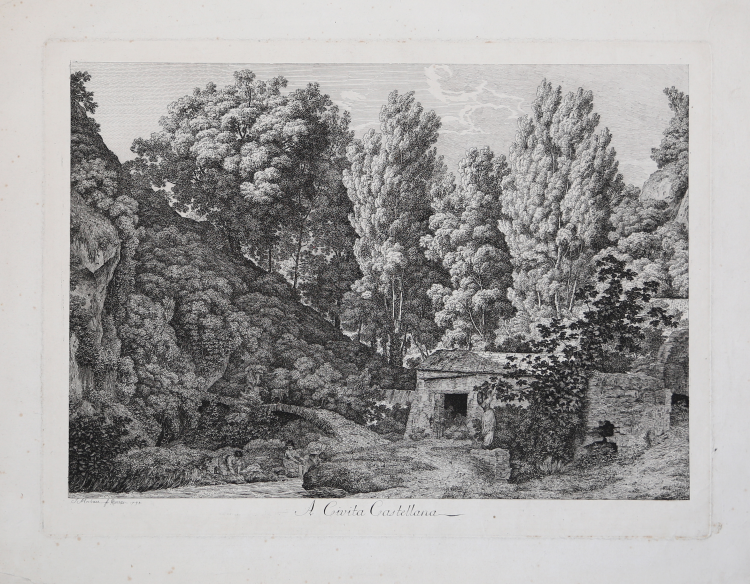



| Reference: | S40636 |
| Author | Jacob Wilhelm MECHAU |
| Year: | 1799 |
| Zone: | Civita Castellana |
| Printed: | Nurnberg |
| Measures: | 380 x 280 mm |


| Reference: | S40636 |
| Author | Jacob Wilhelm MECHAU |
| Year: | 1799 |
| Zone: | Civita Castellana |
| Printed: | Nurnberg |
| Measures: | 380 x 280 mm |
Etching from the famous series "Collection ou suite pittoresque de l'Italie dessinées d'après nature et gravées à l'eau forte a Rome par trois peintres allemands AC Dies, Charles Reinhart, Jacques Mechau", 1792 -98, 1799.
A series of 72 views taken from nature and engraved in Rome together with Johann Christian Reinhart, whom he had met in Dresden, and Albert Christoph Dies. The collection was published by Johann Friedrich Frauenholz in Nuremberg in 1799.
Good condition.
Jacob Wilhelm MECHAU (16 gennaio 1745, Lipsia - 14 marzo 1808, Dresda)
|
Was a German painter, draughtsman and engraver. Like few contemporaries, represents the transition from classicism to early romanticism.
He studied in Berlin, where he was trained by Bernhard Rode for three years in his private living room, but also received lessons from the director of the Academy of Arts, Blaise Nicolas Le Sueur (1716-1783), and his student Paul Joseph Bardou. Later (1770) Mechau turned to Dresden to study at the Dresden Academy of Art.
In September 1776, almost exactly between Winckelmann's death and Goethe's Grand Tour, he traveled to Italy, stopping in Rome and devoted himself to landscape painting. His role models were Claude Lorrain and Jakob Philipp Hackert.
In the following period (1792-1798), among other works, was created the famous series of etchings "Collection ou suite pittoresque de l'Italie dessinées d'après nature et gravées à l'eau forte a Rome par trois peintres allemands AC Dies, Charles Reinhart, Jacques Mechau", 1792 -98, 1799. A series of views taken from nature and engraved in Rome together with Johann Christian Reinhart, whom he had met in Dresden, and Albert Christoph Dies. The collection was published by Johann Friedrich Frauenholz in Nuremberg in 1799.
Due to the French occupation in 1798, Mechau had the opportunity to return to Germany for the last time, this time to Dresden, where he stayed until the end of his life and created motifs mainly with Saxon landscapes. His series of seven landscapes, exhibited in 1807, represents the transition to romanticism.
|
Jacob Wilhelm MECHAU (16 gennaio 1745, Lipsia - 14 marzo 1808, Dresda)
|
Was a German painter, draughtsman and engraver. Like few contemporaries, represents the transition from classicism to early romanticism.
He studied in Berlin, where he was trained by Bernhard Rode for three years in his private living room, but also received lessons from the director of the Academy of Arts, Blaise Nicolas Le Sueur (1716-1783), and his student Paul Joseph Bardou. Later (1770) Mechau turned to Dresden to study at the Dresden Academy of Art.
In September 1776, almost exactly between Winckelmann's death and Goethe's Grand Tour, he traveled to Italy, stopping in Rome and devoted himself to landscape painting. His role models were Claude Lorrain and Jakob Philipp Hackert.
In the following period (1792-1798), among other works, was created the famous series of etchings "Collection ou suite pittoresque de l'Italie dessinées d'après nature et gravées à l'eau forte a Rome par trois peintres allemands AC Dies, Charles Reinhart, Jacques Mechau", 1792 -98, 1799. A series of views taken from nature and engraved in Rome together with Johann Christian Reinhart, whom he had met in Dresden, and Albert Christoph Dies. The collection was published by Johann Friedrich Frauenholz in Nuremberg in 1799.
Due to the French occupation in 1798, Mechau had the opportunity to return to Germany for the last time, this time to Dresden, where he stayed until the end of his life and created motifs mainly with Saxon landscapes. His series of seven landscapes, exhibited in 1807, represents the transition to romanticism.
|